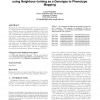Free Online Productivity Tools
i2Speak
i2Symbol
i2OCR
iTex2Img
iWeb2Print
iWeb2Shot
i2Type
iPdf2Split
iPdf2Merge
i2Bopomofo
i2Arabic
i2Style
i2Image
i2PDF
iLatex2Rtf
Sci2ools
GECCO
2005
Springer
2005
Springer
A GA for maximum likelihood phylogenetic inference using neighbour-joining as a genotype to phenotype mapping
Evolutionary relationships among species can be represented by a phylogenetic tree and inferred by optimising some measure of fitness, such as the statistical likelihood of the tree (given a model of the evolutionary process and a data set). The combinatorial complexity of inferring the topology of the best tree makes phylogenetic inference ideal for genetic algorithms. In this paper, two existing algorithms for phylogenetic inference (neighbour-joining and maximum likelihood) are co-utilised within a GA and enable the phenotype and genotype to be assigned quite different representations. The exploration vs. exploitation aspects of the algorithm are examined in some test cases. The GA is compared to the well known phylogenetic inference program PHYLIP. Categories and Subject Descriptors J.3 [Life and medical sciences]: Biology and genetics; F.2.2 [Nonnumerical algorithms and problems]: Sorting and searching; I.5.3 [Pattern recognition]: Clustering General Terms algorithms Keywords p...
| Added | 29 Jun 2010 |
| Updated | 29 Jun 2010 |
| Type | Conference |
| Year | 2005 |
| Where | GECCO |
| Authors | Leon Poladian |
Comments (0)

